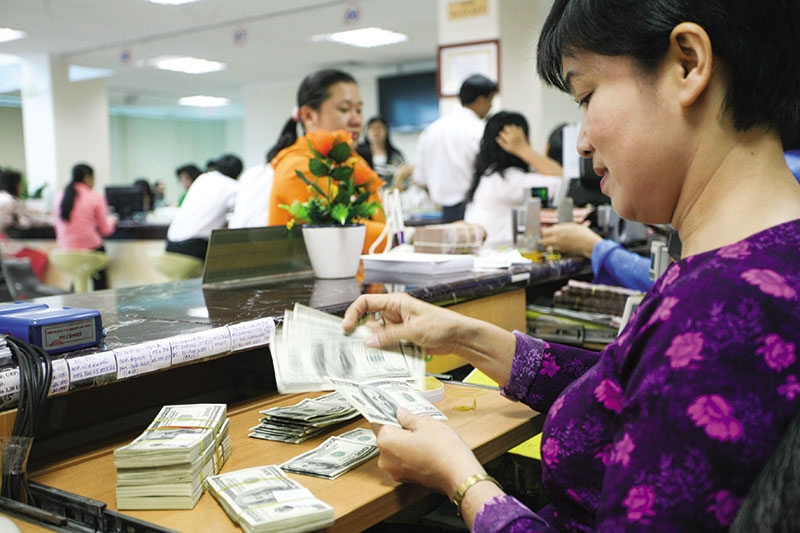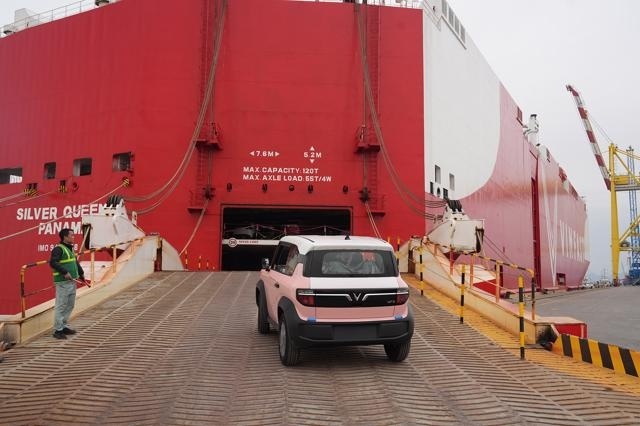FX rates could boost inflation
 |
| Many companies are still unaffected by FX movements but may face troubles in the future, Photo: Le Toan |
FX taking toll on businesses
Despite the devaluation of the VND against the USD in recent months, businesses in Vietnam with exposure to FX rates said that they are immaterially affected by such movement in the short term.
The daily fixing reached a new high of VND22,686 a dollar at the start of last week, up VND10 against the closing rate of the previous week. The FX rate at commercial banks then climbed to as high as VND23,364 a dollar last Wednesday, on a 3-per-cent trading band that bounded the ceiling rate at VND23,366 and floor rate at VND22,004 a dollar for the day.
For Taiwanese-invested enterprise Vietnam Fortress Tools JSC (Fortress), which manufactures garden tools and wooden toys, the recent development of the FX rate could in fact help reduce the company’s input prices in the short term.
“Some of our input costs, in this case the price of steel imported from China, could go down as the Chinese yuan is devalued [against the USD]. However, as a majority of our raw materials are sourced from Taiwan and Vietnam, the impact of the FX rate on our imported materials is insignificant,” said Vi Nguyet Cam, investor relations manager at Fortress.
In the long term, the rise of the USD against the VND could take its toll on companies by increasing interest payments and rising inflation that could lead to a swell in inputs, including wages, logistics, and import-export activities, according to Cam.
“Nevertheless, being an exporter of good reputation in both the US and the EU, with over 95 per cent of our revenue denominated in USD, we are able to balance our cashflow for our imported materials as well as the principal and interest payments,” she said.
Meanwhile, according to Le Van Diep, deputy general director of Minh Phu Seafood JSC, the annual export turnover of which amounts to $500 million, the company’s profit is vulnerable to FX fluctuations, as it has to regularly import a large volume of feed and packaging materials from overseas.
Diep said that since the second quarter, Minh Phu’s international rivals have gained competitiveness in terms of price, as a result of their domestic currency’s devaluation against the dollar. To compete with them, Minh Phu cannot lift its output price and sees tightening profit margins.
Minh Phu, however, receives much of its revenue in dollars, so it can use this as collateral against its USD-denominated loans that enjoy a lower interest rate, which, in turn, helps the company decrease its expenses.
International logistics service providers Bee Logistics Corporation and NR Greenlines Logistics Co., Ltd., a joint venture between Railway Transport and Trade JSC (Ratraco) and Japan’s Nissin Group, also told VIR that they do not see a threat in the FX market movements for the time being, as their businesses have prepared an FX hedge in advance to minimise FX risk.
To minimise FX risk and cut input costs, Fortress said that it is going to diversify its input supply through local sourcing.
In addition, taking advantage of the US-China trade tensions, Fortress is now in a position to enhance its market share in the US and EU, where its products gain a competitive advantage over similar ones from China.
“With regard to the US market, we have received an increasing number of orders from customers who wish to switch from China to Vietnam due to the rising tension between the US and China,” noted Cam.
With the US imposing a 25-per-cent tariff on $34 billion worth of Chinese goods, then later adding another 10 per cent on $200 billion worth of Chinese-made products, and Vietnam now tapping into the EU market through the upcoming EU-Vietnam Free Trade Agreement (EVFTA), Fortress projected that its sales to these markets will dramatically increase, helping to turn its ambition of becoming the world’s largest garden tools manufacturer into reality.
How far has FX gone?
In a recent macro-economic report on Vietnam, Khoon Goh, head of ANZ Asia Research, noted that the dong has been weakening against the greenback since mid-June, with the USD/VND rate seen moving near the top of the trading band at around VND23,350 to the dollar.
The VND movements, as Goh pointed out, have been in line with regional currencies. Notably, the Chinese Yuan was devalued against the USD and the rest of Asia’s currencies also lost value against the dollar.
Noelan Arbis, economist at HSBC, sees the rapid VND depreciation in recent weeks as upside risks to inflation in the country, which could translate to higher domestic prices.
“In fact, we estimate that Vietnam’s FX pass-through is the highest in the ASEAN, with 100 basic points of currency depreciation associated with approximately a 0.25-percentage-point increase in Vietnam’s headline consumer price index. This is because Vietnam is one of the most open trade economies in the region, with imports reaching around 90 per cent of the GDP. This is second only to Singapore, where headline import data reflects the country’s role as a transhipment hub,” he said.
According to Arbis, interbank rates have risen in recent weeks as a result of the State Bank of Vietnam (SBV) selling FX reserves, so a rate hike would complement these actions, while also helping stem the outflow of much-needed reserves.
Looking towards the year’s end, Standard Chartered Bank expects the SBV to remain accommodating in the short term to support growth, despite rate hikes from major central banks. “We expect unchanged policy rates in 2018 and a mild devaluation of the VND. However, the SBV may increase the ceiling on interest on USD deposits, which has been capped at 0 per cent since December 2015, following the Federal Reserve rate hikes.”
While a resilient trade surplus and foreign direct investment remain supportive of the VND, a higher USD and trade war tensions have seen USD/VND (spot and fixing) move gradually higher since the end of 2017. On the whole, though, VND moves have lagged behind the rest of Asia, excluding Japan.
“We may see a mild upward movement in USD/VND in the quarters ahead in order to maintain trade competitiveness. To reflect this, we have revised upwards our USD/VND forecasts to 22,950 for the end of 2018’s second quarter (from 22,650), 22,950 for the end of 2018’s third quarter (from 22,600), and 23,000 for the end of 2018 (from 22,600). We have also raised our projection for 2019 and now forecast 22,800 at the end of 2019 (from 22,600).”
What the stars mean:
★ Poor ★ ★ Promising ★★★ Good ★★★★ Very good ★★★★★ Exceptional
 Tag:
Tag:
Latest News
More News
- Citi named best bond and equity bank by Asia’s leading finance magazines (March 04, 2025 | 17:08)
- Banking sector faces liquidity challenges amid rate cuts (March 03, 2025 | 10:43)
- Positive rate movement following government commitment (February 27, 2025 | 18:04)
- Citi celebrates 30 years of excellence in Vietnam (February 27, 2025 | 17:09)
- Vietnam set to launch KRX trading system in May (February 27, 2025 | 16:20)
- Domestic banks strengthen international partnerships (February 27, 2025 | 11:15)
- Banks pressured to supply capital for public projects (February 27, 2025 | 11:08)
- Anti-laundering legal holes being bridged (February 27, 2025 | 10:20)
- Lenders make radical shifts in workforce structures (February 27, 2025 | 10:06)
- VietBank signs MoU with KPMG (February 26, 2025 | 18:47)



















 Mobile Version
Mobile Version